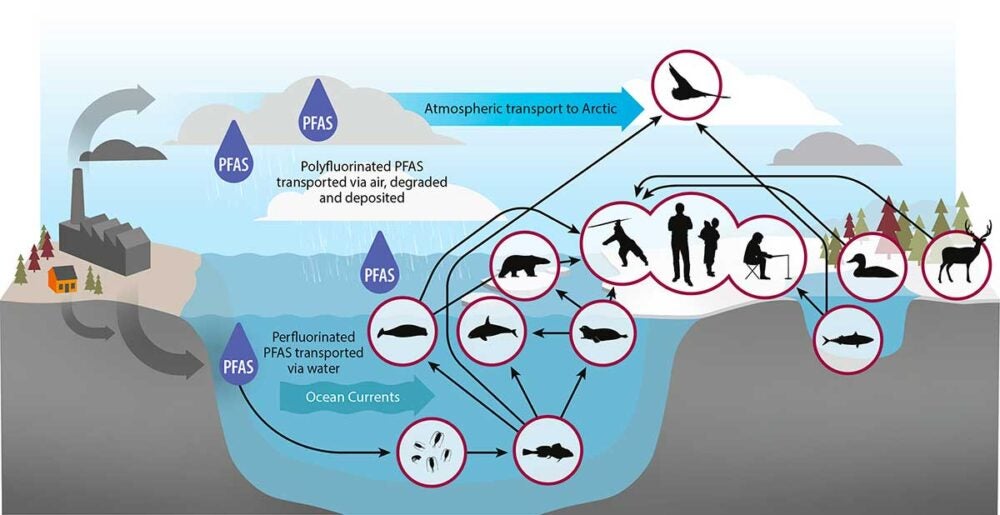One of the key defining factors of persistent organic pollutants (POPs) is an ability to travel long distances from original release points. POPs represent a unique integration of scientific disciplines, including engineers, toxicologists, and environmental scientists, who tackle complex problems. Each POP, including PFAS, warrants study and concern, not only because of long range transport, but also because of the propensity to remain in the environment, in living things, and permeate the entire food chain. This persistence and ubiquity comes with health risks to humans and wildlife.
Let’s get back to the first requirement for POP; the ability for long range transport in air or water. An easy way to visualize: despite release in locations in the US or Canada, PFAS travel far north into the remote regions of the Arctic.
While no factories spew PFAS into the Fram Strait, nor are huge consumer populations flushing PFAS down the drain, researchers still find PFAS in the water, snow, and wildlife. To address this, STEEP director Rainer Lohmann paired with an impressive group of international scientists to detail the current state of science on PFAS in the Arctic.
In a recent paper published in Science of the Total Environment, Lohmann, STEEP Project Leads Philippe Grandjean, Elsie Sunderland, Pál Weihe, and others provide a broad overview of PFAS trends in both human and wildlife populations near the North Pole. The group reviewed a library of existing studies and identified that chemicals such perfluorooctane sulfonate (PFOS) and perfluorononanoic acid (PFNA) were more present in wildlife, with specifically high concentrations found in mammal livers and bird eggs.
Interestingly, PFOS increased in concentrations in Arctic wildlife from 2014-2021, in spite of many bans, phase outs, and warnings about its use. This suggests that while some nations may be moving on from PFOS, new places may have begun manufacturing and using the forever chemical.
The study also addressed human populations in the Arctic, noting that most of the existing studies have focused on the Western Arctic communities. Despite living in such remote areas, far from likely PFAS sources, Arctic communities were found to have detectable levels of PFAS. More importantly, these levels of PFAS were tied to potential impacts on the immune system, reproductive systems, and cardiometabolic systems, among others. Arctic communities rely on seafood, specifically mammal diets, and are likely accumulating PFAS from these food sources.
Review of existing research underscores the importance of “turning off the tap” when it comes to PFAS pollution. PFAS released locally to the ocean can ultimately reach these distant ecosystems and communities, threatening their way of life. When we think of forever chemicals, we often think of their persistence in our bodies or our own water. However, the “forever” implies that they will exist long enough to travel great distances as well, requiring us to maintain a more global frame of mind when considering the impact of PFAS pollution.
Rainer Lohmann, Khaled Abass, Eva Cecilie Bonefeld-Jørgensen, Rossana Bossi, Rune Dietz, Steve Ferguson, Kim J. Fernie, Philippe Grandjean, Dorte Herzke, Magali Houde, Mélanie Lemire, Robert J. Letcher, Derek Muir, Amila O. De Silva, Sonja K. Ostertag, Amy A. Rand, Jens Søndergaard, Christian Sonne, Elsie M. Sunderland, Katrin Vorkamp, Simon Wilson, Pal Weihe,
Cross-cutting studies of per- and polyfluorinated alkyl substances (PFAS) in Arctic wildlife and humans. Science of The Total Environment 2024 Volume 954, 2024, 176274.


